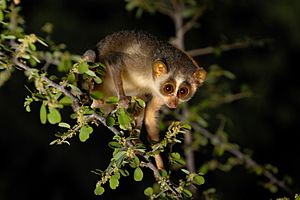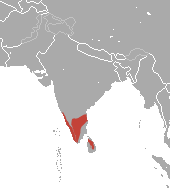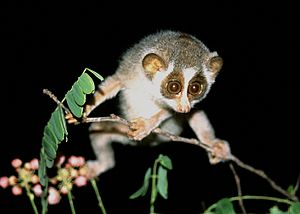Gray slender loris facts for kids
Quick facts for kids Gray slender loris |
|
|---|---|
 |
|
| Conservation status | |
| Scientific classification | |
| Genus: |
Loris
|
| Species: |
lydekkerianus
|
| Subspecies | |
|
L. l. lydekkerianus (Cabrera, 1908) |
|
 |
|
| Gray slender loris range | |
The gray slender loris (Loris lydekkerianus) is a small, shy primate that lives in trees. It belongs to the Loridae family. You can find these animals in India and Sri Lanka. They live in warm, dry forests and moist lowland forests. Sadly, their homes are shrinking due to habitat loss.
Contents
Understanding Gray Slender Loris Classification
The gray slender loris is a type of slender loris. It belongs to the Loris genus. Another species in this group is the red slender loris (Loris tardigradus).
In 1908, a Spanish zoologist named Ángel Cabrera first described a type of slender loris. He named it after an English naturalist, Richard Lydekker. Later, scientists decided there were two main species of slender lorises. These are L. tardigradus and L. lydekkerianus.
The gray slender loris (Loris lydekkerianus) has four different types, called subspecies. These subspecies live in different areas. Two are found in India and two in Sri Lanka.
- Genus Loris
- Red slender loris, Loris tardigradus
- Gray slender loris, Loris lydekkerianus
- Malabar slender loris, Loris lydekkerianus malabaricus
- Mysore slender loris, Loris lydekkerianus lydekkerianus
- Northern Ceylonese slender loris, Loris lydekkerianus nordicus
- Highland slender loris, Loris lydekkerianus grandis
Physical Features of the Gray Slender Loris
Slender lorises have very thin limbs. They also have excellent stereoscopic vision. This means their eyes face forward, helping them see depth. This is useful for moving through trees.
Their fur color can vary a lot. Each subspecies has slightly different fur. Their backs are usually gray or reddish. Sometimes, a darker stripe runs down their back. Their bellies are white or light brown.
Dark fur surrounds their large eyes. A white patch of hair, called the median stripe, is between their eyes. Their snout is larger than that of the red slender loris. Their hands are special, with a small second finger. This helps them grip small branches very tightly. They have almost no tail. An adult gray slender loris is about 18–26 centimeters (7–10 inches) long.
In Sri Lanka, one subspecies, Loris lydekkerianus grandis, has short ears. It also has a heart-shaped face. The hairs on its belly are black at the base. Another subspecies, Loris lydekkerianus nordicus, has white hairs at the base of its belly fur.
Behavior and Habits
We are still learning a lot about the gray slender loris's behavior. Like other lorises, they are nocturnal. This means they are active at night. They come out of their sleeping spots only when the sun sets.
They mostly eat insects. But they also sometimes eat fruits, flowers, or small animals. These can include mice or geckos. In southern India, they often live in forests with acacia and tamarind trees. They can also be found near farms.
Male lorises usually have larger areas where they search for food. They are mostly solitary when they look for food. It is rare to see them in pairs or groups. However, they might sleep together in groups of up to seven. These groups can include young lorises from different litters.
Adult females and males have their own areas. Sleeping groups often include a mother and her young. Lorises talk to each other using different sounds. They also use urine and scent marks to communicate. They can also use smells and visual signals from far away. Lorises interact during the night and sleep in groups during the day. Females usually only interact with their mothers or daughters. Females are more friendly with males who sleep in the same area. Males tend to be more aggressive towards other males not in their sleeping group. However, they are friendly with males in their own sleeping area. Males also help care for infants in their sleeping group. Sleeping together is the main way lorises show social behavior.
Reproduction and Life Cycle
A female gray slender loris carries her babies for about 170 days. It is very common for lorises to have twins. After giving birth, females focus on caring for their young. They do not mate again right away.
Lorises have one of the slowest reproduction rates for small primates.
Where Gray Slender Lorises Live
The gray slender loris lives in southern India and Sri Lanka. They can be found in different types of forests. These include primary and secondary rainforests. They also live in dry semi-deciduous forests and montane cloud forests. They can live at heights up to 2,000 meters (6,560 feet) above sea level.
In southwestern India, the Malabar gray slender loris lives in the wet forests of the Western Ghats. This is in the states of Karnataka, Kerala, and Tamil Nadu. They live up to 1,200 meters (3,900 feet) high. The Mysore gray slender loris lives in the dry forests of the Eastern Ghats. This includes Andhra Pradesh, Karnataka, and Tamil Nadu. They prefer open scrub forests and acacia trees. They live at heights of 300–500 meters (980–1,640 feet). They can also be found on the dry eastern slopes of the Western Ghats.
Conservation Status and Threats
The gray slender loris is listed as "Near Threatened" by the IUCN Red List. This means they could become endangered soon. In India, they are protected under the Indian Wildlife Act of 1972. However, the threats to these primates are growing.
Sometimes, lorises are used in traditional medicine. Some villagers also try to keep them as pets. But lorises are hard to care for, so many of them die. Some zoos keep them, and they are sometimes used by astrologers.
Insects are the main food source for lorises. Farmlands often have many insects because of cattle waste. This means lorises do not compete with humans for food. So, people often tolerate them.
However, their homes are being broken up into smaller pieces. This is called Habitat fragmentation. The loss of acacia trees, which lorises prefer, is also a big problem. Scientists are working on conservation efforts. More research is being done to help protect these unique animals.





